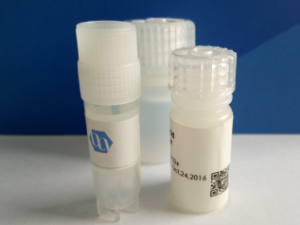$ 950.0
Quantity: 50 MG
In stock (can be backordered)
Description
Product name: Anal 3-Pro
Catalog#: 1399057
Organism:
Synonyms:
CAS NO.:
Sequence: AKKVFKRLPKLFSKIWNWK-NH2
Modifications: C-terminal amide,
M.W:2417.01
M.F.:C120H190N32O21
Purity: 95% by HPLC
Counter ion: Trifluoacetate
Format: Lyophilized powder
Description: We selected Glu9→Pro substitution because the resultant peptide is negatively charged and does not favour electrostatic interaction between itself and the negatively charged bacterial membrane. Moreover, we wanted to introduce a hinge region into the middle of the peptide, and with the exception of Glu, all of the amino acids in that region of the peptide are essential for its antimicrobial activity. This mutation changed the peptide’s conformation because proline is a potent α-helix breaker that has been found in the transmembrane helices of a variety of integral membrane proteins and in a number of α-helical antimicrobial peptides that promote ion channel activity, including melittin, cecropin A, paradoxin, brevinins, gaegurin and buforin II. The primary structures of these cell-selective antimicrobial peptides consist of a hinge (a Pro residue) conecting N- and C-terminal α-helical segments, and two-dimensional NMR studies have shown that these peptides do indeed assume a helix-hinge-helix structure in membrane-mimicking environments. The importance of the Pro residue was confirmed by the findings that Pro14→Ala substitution in the active analogue derived from gaegurin induced a significant reduction in antibacterial activity , while elimination of Pro7 from pardaxin increased hemolytic activity. Anal 3-Pro created a pore <1.8 nm in diameter, which is similar to buforin II. Notably, scanning electron microscopic observation of Candida albicans revealed that Anal 3-Pro and buforin II exert similar effects on cell membranes, whereas magainin 2 exerts a different, more damaging, effect. In addition, Anal 3-Pro assumed a helix-hinge-helix structure in the presence of biological membranes and formed micropores in both bacterial and fungal membranes, through which it entered the cytoplasm and tightly bound to DNA. These results indicate that the bending region of Anal 3- Pro peptide is prerequisite for effective antibiotic activity and may facilitate easy penetration of the lipid bilayers of the cell membrane.
Uniprot ID:
Usage: For Scientific Research Use Only, Not for Human Use.

